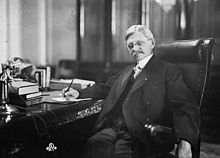Thomas Riley Marshall
Thomas Riley Marshall (born March 14, 1854 in North Manchester , Wabash County , Indiana , † June 1, 1925 in Washington, DC ) was an American politician ( Democratic Party ) and from 1913 to 1921 the 28th Vice President of the United States under Woodrow Wilson . He also served as the 27th governor of Indiana between 1909 and 1913 .
Early years
Thomas Marshall was born the son of doctor Daniel Miller Marshall and his wife Martha Ann Patterson and attended local schools in his home country. In 1873 he graduated from Wabash College . Then he studied law. After his successful exams and his admission to the bar in 1875, he opened a law firm in Columbia City . On October 2, 1895, he married the civil servant's daughter Lois Irene Kimsey. The couple had no children, but from 1917 they looked after the sick son of a couple they were friends with, Clarence Ignatius Morrison, who was born in 1916. The child, called "Izzy", died in February 1920 shortly before his fourth birthday.
Indiana Governor
Until 1908, Marshall had only been politically active at the local level. In 1908 he was unexpectedly nominated as a compromise candidate for his party ( Dark Horse Candidate ) for the gubernatorial election and then elected to this office by the citizens of Indiana. His four-year term began on January 11, 1909. During this time, he repealed the sterilization law passed by his predecessor Frank Hanly . In addition, a new Child Protection Act has been introduced in Indiana. There was also a new labor law and an ordinance on the registration of voters ( Voters Registration Law ). Marshall was unable to push through other plans, such as constitutional reform. It is also worth noting that no executions were carried out during his tenure as governor in Indiana . Marshall's term ended on January 13, 1913.
Vice President of the USA
At the Democratic National Convention in 1912, Marshall was suggested by delegates as a possible presidential candidate. After some discussion, the party congress agreed on Woodrow Wilson as the top candidate. Marshall, however, was nominated as Wilson's running mate for the vice presidency. After the democratic victory in the presidential election , both men were able to take up their respective offices on March 4, 1913. The relationship between Marshall and Wilson was rather cold. Although he was always invited to cabinet meetings , his suggestions were rarely taken into account. In the run-up to the 1916 election , some Democrats even stood up for a different vice-presidential candidate. Wilson, however, insisted on Marshall as vice-president in the interests of the unity of the party. This made Marshall the first vice president since John C. Calhoun in 1828, who was elected to a second term. His second term began on March 4, 1917.
The second term of office was overshadowed by the events of the First World War . Marshall had to travel around the country promoting government bond purchases, explaining federal government policies and soliciting support for the war effort. Since President Wilson was in Europe after the end of the war in 1919 for the negotiations on the establishment of the League of Nations and the Paris Suburb Treaties, Marshall conducted a large part of the official business. However, after Wilson was no longer able to perform his duties due to a stroke in October 1919, he refused to have this established and to be the first acting president to conduct official business, as the procedure required was unclear. However, the actual state of health of Wilson was withheld from him. His term of office, like Wilson's, ended in March 1921. His successor as deputy president was Calvin Coolidge .
Another résumé

After the end of his tenure as Vice President, Marshall retired from politics and returned to practice as a lawyer. He was also the curator of Wabash College and toured the country giving lectures. He died on June 1, 1925 in the federal capital Washington, DC
The place Marshall in Alaska is named after him.
literature
- Jules Witcover: The American Vice Presidency: From Irrelevance to Power. Smithsonian Books, Washington, D. C. 2014, ISBN 978-1-5883-4471-7 , pp. 253-266 (= 28. Thomas R. Marshall of Indiana ).
- Robert Sobel, John Raimo (Eds.): Biographical Directory of the Governors of the United States, 1789–1978. Volume 1, Meckler Books, Westport 1978. 4 volumes.
Web links
- Thomas Marshall in the National Governors Association (English)
- Indiana Historical Bureau (English)
- Thomas R. Marshall in the Miller Center of Public Affairs of the University of Virginia (English)
- Thomas R. Marshall in the database of Find a Grave (English)
- Thomas Riley Marshall in the Biographical Directory of the United States Congress (English)
| personal data | |
|---|---|
| SURNAME | Marshall, Thomas Riley |
| BRIEF DESCRIPTION | American politician, 28th US Vice President |
| DATE OF BIRTH | March 14, 1854 |
| PLACE OF BIRTH | North Manchester , Wabash County , Indiana |
| DATE OF DEATH | June 1, 1925 |
| Place of death | Washington, DC |



